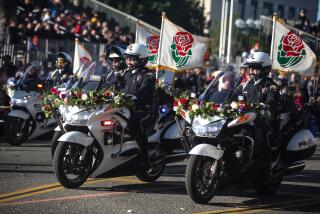BUENA PARK : Dispatchers’ System Goes High-Tech
Gone is the pen and paper.
No longer do police dispatchers write down calls for service or type the daily log.
Those days are gone.
The city’s Police Department communications dispatch center has gone high-tech.
There’s no more hard copy and the new computer-aided dispatch system makes their job a lot easier.
“We went from Barney Rubble to the Jetsons--we left the Neanderthal system,” said Dominic Savino, a dispatcher for 28 years.
The computer system went on-line earlier this month, streamlining the dispatchers’ workload and improving police service to the community.
“It allows them to process and manage the calls of services from citizens and the field patrol units in a much more efficient manner,” said Police Chief Richard M. Tefank.
Chris O’Neal agreed.
O’Neal, who has been a dispatcher for 12 years, said a dispatcher’s priority is to get calls for service to officers quickly--and the computer equipment is expected to improve response time.
“Dispatchers save seconds and seconds save lives,” O’Neal said. “I think now we’re getting a handle on seconds to get those calls out.”
With the computerized system, instead of tracking down an officer when a call for service comes into the dispatch center, the computer keeps track of where officers are in the field, their availability and how long they have been on a call.
The department has eight full-time dispatchers and two part-time dispatchers who handle an estimated 350,000 incoming emergency calls and non-emergency calls for service a year, police officials said.
Police Lt. Rich Ciampa, a watch commander, said the computer technology helps him do his job better.
Ciampa oversees patrol units and the day-to-day operations of the department.
He now has a computer terminal at his desk from which he can continually monitor the activities of patrol officers and crimes as they occur.
He can watch calls that are waiting service, calls that officers are working on and review calls from earlier in the day.
“From my standpoint, it makes things a lot more convenient,” he said.
Tefank also said the system soon will also be used to track and total statistical information and other data.
By this spring, the records-management system is expected to be in operation, he said.
“It will allow us to capture all the information regarding crime reports we process and information on arrestees,” he said, adding that police reports will be stored on optical disks, rather than written on a piece of paper and stored in a file.
This summer, computers will also be placed in police cars to allow officers to “talk” to dispatchers electronically, access databases on suspected criminals and motorists or conduct other information searches.
Tefank said the city spent about $1.2 million to computerize the department.
The new computer equipment was part of the overall plan to update the department’s communications capabilities.
In 1992, a new dispatch center was built and opened next to police headquarters to accommodate the high-tech equipment and improve working conditions.
“Memory is a good skill for a dispatcher to have,” O’Neal said. “But I always felt people’s lives shouldn’t depend on that.”
More to Read
Sign up for Essential California
The most important California stories and recommendations in your inbox every morning.
You may occasionally receive promotional content from the Los Angeles Times.










